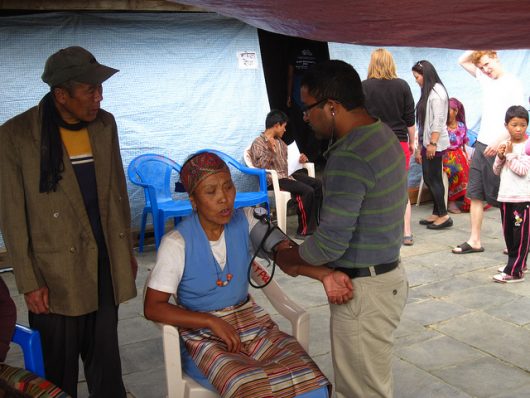Common Diseases in Nepal and Why The Country is Susceptible

In order to talk about common diseases in Nepal, one must first examine some of the facts and statistics that make the country prone to disease. Nepal, a Himalayan country with a population of nearly 29 million, is located in South Asia. It is home to some of the highest mountains in the world, such as the third tallest mountain, Kanchenjunga, situated on the border of Nepal and India, and the world’s highest mountain, Mount Everest, located on its border with China. The birthplace of Gautama Buddha, Nepal is a favorite tourist destination for mountaineers and trekkers, while also attracting visitors for its rich cultural heritage, ancient temples and palaces.
Nepal was a monarchy for centuries until it was abolished in 2008 and the country was declared a republic. It is one of the poorest countries in Asia, and between 2010 and 2011 nearly 25 percent of its population was living on less than $1.25 a day. The mountainous and tectonically active terrain makes Nepal highly prone to natural disasters, which are some of the most common causes of death in the country, and obstruct its development. A devastating 2015 earthquake that killed nearly nine thousand people and injured thousands more remains one of the worst disasters in the country’s history.
Plagued with geological vulnerability, poverty and the associated issues of poor sanitation, air pollution and a lack of proper healthcare, Nepal is replete with both communicable and non-communicable diseases. According to data from the Institute for Health Metrics and Evaluation (IHME) and the World Health Organization (WHO), below is a list of common diseases in Nepal with some of the highest death rates.
Most Common Diseases in Nepal
- Chronic obstructive pulmonary disease (COPD) – The term COPD encompasses a set of chronic lung diseases such as emphysema and chronic bronchitis. It is the leading cause of death in Nepal. COPD killed 17,200 people in the country in 2012, and there was a 22.1 percent increase in its death rate from 2005 to 2015. Long-term exposure to lung irritants causes this disease, and cigarette smoking, use of biomass fuels and air pollution are some of the key risk factors.
- Ischemic heart disease (IHD) – Also called coronary artery disease, IHD killed 17,100 people in Nepal in 2012 alone and is the second leading cause of death in the country. The major predisposing factors for this disease are high blood pressure, smoking, poor diet and diabetes. The country saw a surge in some of the conventional risk factors such as obesity and hypertension.
- Cerebrovascular disease – Cerebrovascular disease encompasses a set of disorders that affect blood vessels and alter blood supply to the brain, which can lead to a cerebrovascular accident (CVA), also known as a stroke. A leading cause of mortality in the world, strokes killed 15,300 people in Nepal in 2012. The country has seen a 25.7 percent increase in its death rate since 2005. Hypertension, cigarette smoking, alcohol consumption and diabetes are the main risk factors for strokes.
- Tuberculosis (TB) – An airborne bacterial infectious disease, TB is a major public health threat in Nepal. With several innovative programs run by the government in close partnership with collaborators, Nepal has achieved tremendous progress in controlling TB, and there has been a 19.1 percent decrease in TB related death rate from 2005 to 2015. Still, TB remains one of the major causes of death in the country.
- Lower respiratory infections – Lower respiratory infections are some of the most common infectious diseases and are a leading cause of morbidity and mortality in children and adults worldwide. They include conditions such as pneumonia, acute or chronic bronchitis and bronchiolitis. These diseases in Nepal were responsible for 13,100 deaths in 2012. As with TB, the last decade saw an impressive decrease (42.3 percent) in its death rate in the country.
According to the annual report of the Department of Health Services, Government of Nepal, for the years 2014 and 2015, combined efforts by the government and various national and international organizations toward the prevention and control of diseases in Nepal have achieved improved health outcomes over the years. These outcomes include higher life expectancy and reduced maternal and infant mortality rates. The report also identifies existing problems and challenges in the health sector and delineates possible actions for addressing these issues for continued progress.
– Ranjna Madan-Lala
Photo: Flickr
